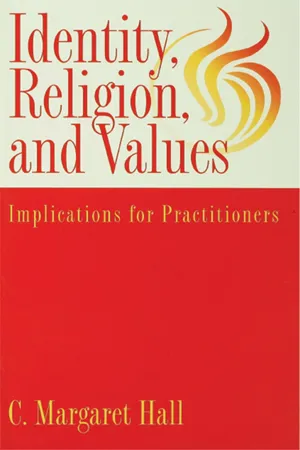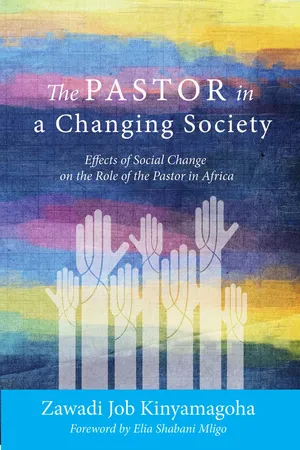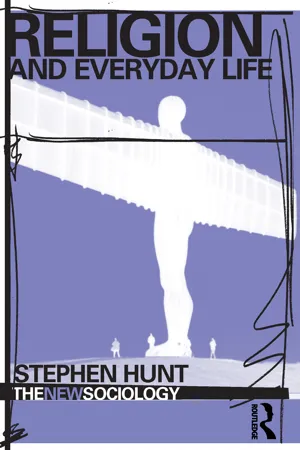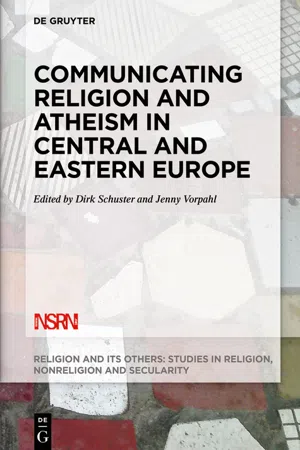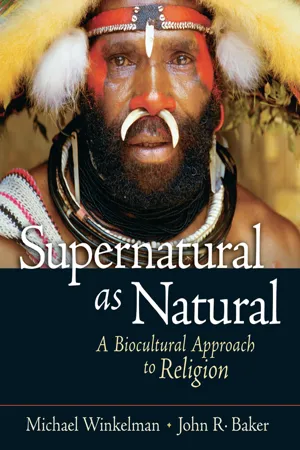Social Sciences
Social Change And Religion
Social change and religion refer to the impact of religious beliefs, practices, and institutions on societal transformation. This includes how religion can both support and resist social change, as well as how social change can influence religious beliefs and practices. The relationship between social change and religion is complex and varies across different cultures and historical periods.
Written by Perlego with AI-assistance
Related key terms
7 Key excerpts on "Social Change And Religion"
- eBook - ePub
Indentity, Religion And Values
Implications For Practitioners
- C. Margaret Hall(Author)
- 2013(Publication Date)
- Taylor & Francis(Publisher)
Chapter 10Social Change And ReligionHistorically, religions have served as both conservative forces and catalysts for change. In their capacities as repositories of meanings, religions can motivate large numbers of individuals—even whole populations—either to sustain traditions or to reformulate goals and ideals and do things differently (Lenski, 1951). Moreover, it is only through using a broad historical perspective that people can sufficiently understand the depth and scope of religious influences, and the strength of their impact on the quantity and quality of social life and social change (Ashbrook, 1993).Religious differences have caused violently destructive battles in many times and places (Eisler, 1987). This destruction is linked to religions because abstractions and rigidities in belief systems frequently generate dogmas that provoke disputes and conflicts (Finke & Stark, 1992). It is this kind of bigotry that accentuates religious differences so much that they become irretrievably contradictory and incompatible, with the result that national and international disagreements may escalate into overt conflict and warfare (Eisler, 1987; Lerner, 1986).Religions can be thought of as consisting of those beliefs that are both individually and socially experienced as sacred (Wuthnow, 1992). Although it is crucial to forge identities through basing actions on uniqueness, and through expressing specific values of meaningful groups, there is also a point at which it is important deliberately to identify with the whole human race. For example, although it may be meaningful to identify with all women, it is also morally significant to conduct behavior according to membership in humankind. Although many people realize that there is no escape from the human condition, and that biology knows few cultural or status differences, these universal characteristics and realities have to be actively acknowledged for people to identify with the whole human race. Even where nation states no longer completely define citizens’ everyday circumstances, as they did in the 18th century, awareness of their membership in the world community must be cultivated—an awareness that in fact is facilitated by modern scientific and technological advances (Appleyard, 1993). Group moral agencies such as religions or even political parties may be prime movers of change, but individuals and groups must recognize and accept their responsibilities for the implementation and consequences of the particular changes they initiate. - eBook - ePub
Religion, Culture & Society
A Global Approach
- Andrew Singleton(Author)
- 2014(Publication Date)
- SAGE Publications Ltd(Publisher)
Important nineteenth-century thinkers, like Max Weber and Emile Durkheim, had much to say about religion. Their work and its enduring influence is the subject of the next chapter. Indebted to these early thinkers, contemporary social scientists focus on the interrelationship between religion and the social and cultural worlds. Any aspect of religion can be studied, large-scale or small: religious change at a societal level, the functioning of religious organizations or the contours of personal religiosity. The social scientific study of religion considers the interrelationship between religion, culture and society in two key ways. The first of these examines how social and cultural factors influence religion. I consulted several recent issues of a field-leading journal, the Journal for the Scientific Study of Religion (JSSR), and as expected, found many excellent examples of this kind of analysis. Jonathan Hill (2011), for example, examines the impact college education has on aspects of religious belief. Using representative survey data and some sophisticated statistical methods, he finds that ‘some, but not all, religious beliefs are altered by higher education … respondents become slightly more skeptical of the super-empirical if they attend and graduate from college’ (Hill 2011: 548). Here, Hill examines how the culture of university influences personal religiosity. Sociologists of religion also examine the ways in which society, groups and individuals are influenced by religion. Another example from the JSSR illustrates this kind of analysis. Emily Sigalow and colleagues (2012) examine the extent to which religious factors influence decisions about career choice, marriage, place of residence and fertility decision-making. They found that ‘particular religious communities differ in their emphasis on the role that religion plays in everyday life - eBook - ePub
The Sociology of Education
An Introduction
- Ivor Morrish(Author)
- 2019(Publication Date)
- Routledge(Publisher)
Education in our society is increasingly concerned with the indigenous regional differences, with urban and rural variety, and with the rapidly developing multi-racial and multi-cultural elements. There is also the additional problem of the fragmented and fragmentary sub-cultures, which arise suddenly and almost as suddenly die, change or become transformed or subsumed in the main cultural stream.Change of any sort is very painful to many people who have established their own norms, standards and concepts of stability. For some social change can be an unnerving, disorientating, even neurotic experience, with sometimes a violently changing scale of values and morals. New techniques and technologies require some sort of adaptation or accommodation by everyone, but, in the words of Professor P. H. Taylor, '"The enemy" is not only - and perhaps, not significantly - social change but our own perceptions' (54) .This is very deeply true in the sense that 'the enemy' is within ourselves, in our very attitudes towards change itself. Our rejection of change, our inability to adapt to it, our fear of the novel and unfamiliar - these are very often the things that make real social progress difficult, if not impossible. Education must therefore be for mobility, for flexibility of thought and action, for the production of individuals with a high general level of culture calculated to make them 'adaptable to changing economic and social conditions'(55) .References
1 Vide Weber, Max, The Sociology of Religion (Methuen, Social Science Paperbacks, 1966), in particular Chapter XIII, 'Religious Ethics, the World Order, and Culture'.2 Vide Hume, D., Essays, Literary, Moral and Political (Ward, Lock and Co., n.d.), Essay XXXIX, 'An Inquiry Concerning Human Understanding', Section VII, Of the Idea of Necessary Connection', pp. 343-55.3 Vide Firth, R., Tikopia Ritual and Belief (Allen and Unwin, 1967); Worsley, P., The Trumpet Shall Sound: A Study of 'Cargo' Cults in Melanesia (London, 1957); Lanternari, V., The Religions of the Oppressed - eBook - ePub
The Pastor in a Changing Society
Effects of Social Change on the Role of the Pastor in Africa
- Kinyamagoha(Author)
- 2014(Publication Date)
- Resource Publications(Publisher)
According to Knitter, the face of the Church started to change since the first society started to move. The movement of Judaism into the Greco-Roman world affected everything that Christianity possessed, inclined, and adhered. The social movements affected liturgies, sacramental practices, rituals, organizational and legislations structures with their policies, and doctrines. One may presume that, the cultic impressions of moving seem a non–stop practice. Consequently, as the movement takes place, there happens the change and reshaping of congregations with their roles and practices. The social movement strongly influences while changing even the religious traditions. In supporting this argument, Ellingson states that:Religious traditions, like many other cultural objects, are not static but are constantly in flux. Most explanations of religious change start from the premise that rituals, theologies, or congregational cultures, like other forms of culture, are relatively stable and do not change until social structures or cultures outside the religious organization change. This is the fundamental premise . . . on culture, action, and change: ideologies and cultural repertoires do not change until the social world becomes unstable, and when this happens individuals and groups are compelled to rework their cultural repertoires or create new ideologies because the “unsettled times” or social crises have rendered the old meanings and practices obsolete. . . . While external social forces influence religious change, they do not necessarily catalyze change as directly as the literature. Traditions change in part because large social forces outside the tradition impinge on our ways of thinking and acting outside the doors of the church. . . . Congregations must decide collectively that the new context is relevant and thus requires some response.416This quotation as well gives a picture of how social movements are very affective to church theories and practices. External social forces have powerful influences over religion with its traditions. It means that, society can change everything depending on its needs, demands and interests. The same happens if society gets into crises or into unsettled times, its impacts affects the Church and all religious practices. The opposite also may be, the stable society, is the stable the church (religion). - eBook - ePub
- Stephen Hunt(Author)
- 2013(Publication Date)
- Routledge(Publisher)
1CONTEMPORARY RELIGION
CHANGING DEFINITIONS
DEFINITIONS OF RELIGION
The matter of the nature and significance of religion in contemporary Western societies, and debates regarding possible decline or resurgence, open up broader questions regarding its definition which, in turn, relate to on-going ideological debates as to the merits or otherwise of religious life. In terms of definitions, the sociology of religion faces a unique set of conceptual difficulties which are enhanced by the increasing variety and ever-changing expressions of religiosity, especially their apparent increasing reduction to the individual and privatized level. Thus, only when it is defined can religion be delimited in terms of the subject matter, the trajectories of its transformation understood, and the conjecture that certain forms are experiencing growth, be put in rightful perspective. This is an important endeavour, especially in relation to current sociological theorizing which departs so radically from the conventional secularization thesis.To be sure, the human capacity for belief is seemingly endless, and in Western societies today there would appear to be a vast range of belief systems, some very loosely articulated. Alongside mainstream Christianity are the world religions or a particular tradition of them as embraced by many ethnic groups, one variety or another of fundamentalism, New Religious Movements and those not so new, and the diverse New Age phenomenon and related forms of spirituality. To these might be added the ‘implicit’ or ‘quasi’ religions — those social phenomena which are ‘like’ religions in some way but which may not include all the usual attributes and perhaps may not even be accepted as a ‘religion’ by participating social actors. Such diversity renders a discussion of religion, especially at the level of everyday life, a demanding challenge. To some extent this is because it is virtually impossible to differentiate between what is ‘in’ and what is ‘out’, that which can correctly be called religion and that which cannot. This is compounded by the problem of measuring the impact of religiosity at the everyday level — a problem further accentuated by the changing cultural perception of the word ‘religion’ itself. Put succinctly, the term appears to have gone out of vogue, with ‘spirituality’ often being preferred, not least of all by those who themselves seek to indulge in new forms. - Jenny Vorpahl, Dirk Schuster(Authors)
- 2020(Publication Date)
- De Gruyter(Publisher)
However, the effect of the socialist system on the religiosity of the society was still considerable. I will try to present this from a sociology of knowledge perspective in the next section.4 Approach to religious change from a sociology of knowledge perspective
Studies examining the effect of religious socialization on religiosity focus on its three main agents: family, peers and church, ultimately concluding that family is the key agent in this process.28 The role of religious socialization is to develop a worldview, which is basically built upon discussion and other forms of communication with others (parents, peers, etc.), yet “if such conversation is disrupted, the world begins to totter, to lose its subjective plausibility.”29 The subjective reality of this world hangs from a “thin thread of conversation.”30 On the disruption, Berger also mentions the ‘leaving of a social milieu,’ which from another perspective can be a change in the social milieu, the loss of a habitual and accepted worldview. I argue that, during the socialist system, the process of transmitting religious knowledge through socialization was radically changed by erasing religion from the public sphere, abolishing religious organizations and existing communities which were – besides family – the common and fundamental spheres of religious knowledge transmission.Similarly to what was meant by the expression “Whoever is not with us is against us,” which in the first period of the system served to describe the attitude of the system toward anyone who did not want to be part of it, religious institutions functioning outside of the private sphere were now considered the enemy. This hostility toward any and all forms of public religiosity did not result in the disappearance of religion from the public sphere. It was there, in a hidden form, hand in hand with the political resistance, while it was also part of the private sphere just as before. Besides the political aspect of strengthening religiosity, religious socialization still had a significant effect on social resistance to the undermining of religion, since the majority of society was socialized before the socialist system was put in place. Thus, in this period, confining religion to the private sphere could happen only in theory.- eBook - ePub
Supernatural as Natural
A Biocultural Approach to Religion
- Michael Winkelman, John R. Baker(Authors)
- 2015(Publication Date)
- Routledge(Publisher)
Religion projects a cosmic order that serves as a general model of the Universe, and then socializes human beings to help to ensure that people’s morals, emotions, and judgments conform to these ideals. Symbol System. Religion expands the functions of symbols beyond their ordinary capacities. Symbols normally refer to things that we can see and touch, but in the context of religion, symbols are used to refer to things that we may never see or touch and even to things that we may be unable to experience or conceptualize. The symbols of religion not only depict Gods as social beings, but also draws on an interrelated set of symbols—a model of the Universe—that provides explanations for many aspects of human existence. Religious beliefs embody models for psychological (personal) and social reality. The norms, values, beliefs, and requirements of religion play a fundamental role in shaping individual social and psychological development. Consequently, one fundamental effect of religion is to teach individuals to understand the Universe. Moods and Motivations. Religion is one of the most significant cultural systems involved for socializing a person’s “moods and motivations.” Religion both shapes our innate emotional dispositions and elicits new emotional experiences and concerns. One fundamental function of religion is to channel the wide range of possible human developmental patterns into a particular configuration of dispositions involving habits, preferences, skills, attitudes, and motivations. Motivations are a particularly important aspect of religious socialization because they create a persistent tendency for humans to seek certain kinds of experiences and engage in certain kinds of behaviors. Religious socialization normally creates specific expectations regarding moods in different circumstances
Learn about this page
Index pages curate the most relevant extracts from our library of academic textbooks. They’ve been created using an in-house natural language model (NLM), each adding context and meaning to key research topics.
